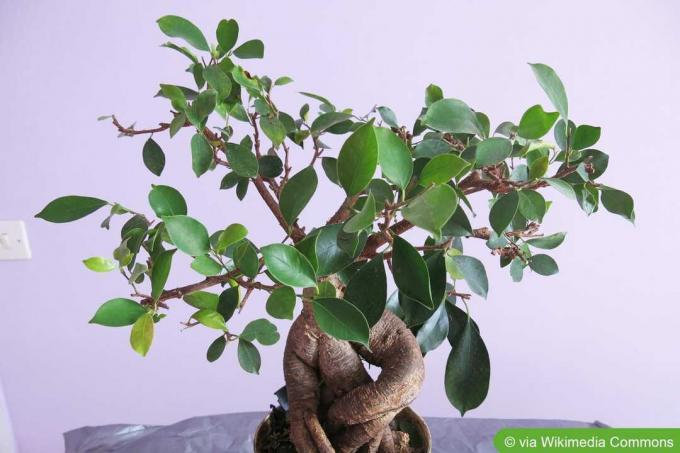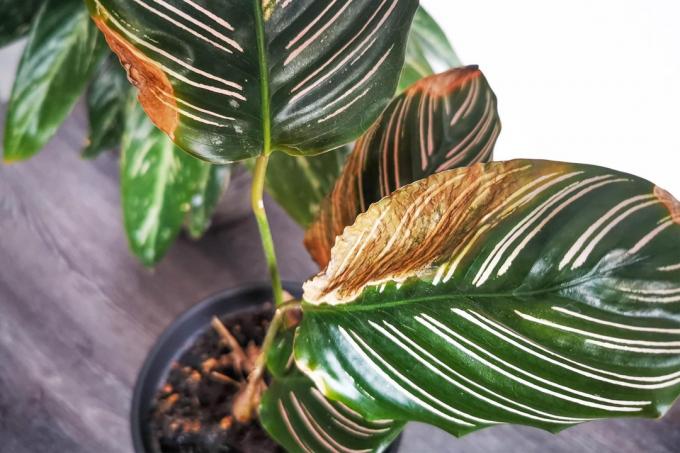

Table of contents
- Location
- substrate
- Pour
- Fertilize
- Cut
- wire
- repot
- hibernate
- Editor's conclusion
- Worth knowing about the Chinese fig tree in brief
Garden art began in the imperial palace gardens of ancient China and has lost none of its fascination to this day. The bonsai design pursues the goal of cultivating a mighty tree in miniature. This requires a lot of patience on an almost meditative level. Anyone who wants to tap into this magic will find the ideal companion on the way to their first, self-created work of art in the Ficus retusa. How to care for a Chinese fig tree as a bonsai is summarized here.
Location
A Chinese fig tree is a wonderful addition to the list of suitable tree species for cultivation as indoor bonsai. According to the original philosophy of this garden art, the symbolic fusion of man and nature takes place in the open air. In order for the masterpiece to succeed indoors, only selected species such as the Ficus retusa are suitable. However, this does not conflict with the fact that as a bonsai it can enjoy the fresh air and sunshine on the balcony throughout the summer. This is how the location should be.
- bright location with sun in the morning or evening hours
- protect from direct sunlight
- warm temperatures of 15 to 25 °C
- from May to September in the garden, on the balcony or the terrace
- now and then a rain shower strengthens the resistance
A high level of humidity in its immediate vicinity strengthens the vitality of the sapling. In living rooms, humidifiers, an indoor fountain or bowls filled with water are suitable. Spoil your bonsai from time to time with a fine spray of lime-free water, the foliage will thrive all the more beautifully.
substrate
A highly relevant criterion in the successful care of a Ficus retusa as a bonsai is the quality of the substrate. Since only a minimal volume of soil is available for the root system in the tiny bowl, normal bed soil understandably does not meet the requirements. Therefore, choose one of the following variants:
- special soil for bonsai from the specialist shop
- a proprietary mixture of loamy garden soil, sand and pricking substrate
- a mix of one third each of hummus, akadama and lava granules
- optionally one quarter each of Akadama and pumice gravel with two quarters of potting soil
The professionals among bonsai gardeners swear by Akadama as a substrate. This is a mineral granulate, which is also known as red ball earth. It offers superior water retention combined with excellent air permeability.
Pour
The very finely structured root system of the Ficus retusa does not tolerate drought. So that the substrate neither dries out nor gets completely soaked, a little finesse is required. Moisture is checked once a day by placing fingertips on the potting soil. In addition, a very light color of the soil also signals a need for water.
- water with room-warm rainwater in the morning or in the evening
- shower over very dry substrate in several passes
- the entire root ball must be moistened
The immersion method has proven to be best for watering a bonsai. The Chinese fig tree is placed in a bowl of water with the peel until no more air bubbles rise. The excess water then runs off through the opening in the bottom before the tree returns to its original place.
Fertilize
A Chinese fig tree is just as hungry for nutrients as a bonsai as it is as a mighty giant tree. In view of the urgent narrowness in the shell, only a liquid fertilizer comes into question. Special preparations from specialist shops are precisely tailored to the requirements thanks to a balanced composition of sodium, phosphorus and potassium.
- Fertilize every 14 days from March to September
- never apply the preparation to a dried substrate
Cut
The heart of a successful care of the Ficus retusa as a bonsai is the regular shape and maintenance cut. With the help of suitable tools, you defy the graceful silhouette of the wood in a perpetual rhythm of cutting back and letting it grow.
- Prune the Chinese fig tree every 6 weeks from May to September
- Shorten shoots that grow out of the contour
- apply the scissors 2-3 mm diagonally over one eye
- do not leave a thicker branch over a narrower branch
The placement of a bud on the branch indicates the direction in which further branching then runs. For example, if you aim for a branch to branch off to the right, it will be cut short of a bud pointing in that direction.
Tip:
A targeted root cut ensures a harmonious relationship between the tree crown and the root area every time you repot.
wire
The Ficus retusa is constantly striving to grow taller, which you can control by pruning. In order for a bonsai to actually take on the intended three-dimensional silhouette, direct the growth in that direction by wiring the branches. For this purpose, select suitable shoots in early spring that are not very woody and therefore flexible.
- twisting an aluminum wire around a branch in a spiral
- wrap loosely at a 45 degree angle from the thick to the thin end
- Buds and leaves must not get under the wire
An ideal wire is about one-third the thickness of the branch it is holding. After 4-6 weeks it is to be removed again so that it does not grow into the bark.
repot
After 2 to 3 years, the bonsai soil is exhausted by regular watering, clumps and has lost its loose consistency overall. If individual roots also make their way outwards, the time is ripe for repotting. With a sharp knife, first loosen the root area from the edge of the bowl and remove the Chinese fig tree from the container. This is thoroughly cleaned with hot soda water. A root claw is now helpful to remove the old substrate. After this preparatory work, it goes like this:
- Shorten the roots by a third with disinfected scissors
- create a 1 cm high drainage of pebbles over the bottom opening of the dish
- spread a first layer of the substrate over it
- use the bonsai in such a way that the roots are evenly distributed over the earth
- only fill the rest of the bonsai substrate so high that a small pouring edge remains
the substrate should fill all cavities and be compacted a little by hand. Finally, moisten the soil with a fine spray. A thin layer of moss is recommended, which has a regulating effect on air circulation and keeps the potting soil moist for longer.
hibernate
If a Chinese fig tree was allowed to spend the summer outdoors, it moves indoors in the fall. At the latest when the temperatures drop permanently below 15 °C, the time has come. The bonsai spends the dark season in a location that is as bright as possible, such as the south window, at ideal temperatures of 22-25 °C. A pad made of insulating styrofoam prevents cold bridges on the window sill. While the amount of irrigation water should be reduced somewhat, regular spraying should not be neglected, given the very dry heating air. Don't fertilize during the winter.
Editor's conclusion
To tap into the age-old gardening art of bonsai design, a Chinese fig tree serves as a prime choice to get started. Thanks to its frugal demands on care, minor beginner mistakes have no significant consequences. As long as the Ficus retusa gets a warm, semi-shady location and gets a balanced supply of water and nutrients, you can successfully defy the desired mini format.
Worth knowing about the Chinese fig tree in brief
Care
- Ficus Retusa is also called Chinese fig tree designated. He is mostly called bonsai-plant kept.
- This tropical plant needs a bright spot. North windows are not suitable.
- In the case of south-facing windows, shade must be provided during midday in summer.
- An outdoor space is also suitable during the summer months.
- Wind and rain make the leaves harder and therefore more resistant to Diseases and pests.
- Temperature fluctuations and drafts should be avoided, as the plant often reacts to this by dropping leaves.
- The Ficus Retusa also reacts in this way at temperatures below 15 ºC. Temperatures around 20ºC are ideal.
- Floor heat is particularly important. Underfloor heating is ideal. Cold feet should be avoided.
- The plant must never dry out completely so that the roots do not die.
- If the soil is too dry, you can also dip the pot so that the soil can really soak up water again.
- Rainwater or stagnant water is suitable as irrigation water. The plant also likes being showered.
- In summer you have to make sure that the sun does not shine, so that the leaves do not burn. In winter it is poured more sparingly.
- During the growing season, between spring and autumn, the trees are fertilized regularly once a month.
- Fertilization is suspended during flowering and after repotting.
pruning
Ficus Retusa is pruned when kept as a bonsai. In order to achieve its typical growth form, branches, twigs, shoots and roots have to be cut back again and again. Depending on the growth, the trees are cut once in the spring or during the entire growth period until autumn, because they sprout again and again. The roots are cut back when transplanted. There must be a balance between crown and roots.
wintering
The Ficus Retusa is repotted every 2 to 5 years. The right time is spring or autumn. A bright place near a window is suitable for wintering. Temperatures must be above 15ºC. Humidity should be high even in winter, so you can spray the plant every now and then. Temperature fluctuations should be avoided, as should drafts. A slight loss of leaves during the dark season is usually unavoidable unless one is used plant light and that about 12 hours a day.
 garden editorial
garden editorial I write about everything that interests me in my garden.
Learn more about houseplants

16 cat-friendly houseplants
If you share an apartment with a cat, you should not have any poisonous indoor plants, because cats occasionally eat the greenery. There are many cat-friendly houseplants that are harmless and can recover quickly once a cat has bitten them.

Calathea gets brown leaves: how to save?
The foliage of a calathea, also known as a basket marante, has its price. And that doesn't mean the purchase price. The tropical plant wants to be cared for and feels like it is in its native rainforest. She expresses her dissatisfaction with unfavorable living conditions with brown leaves.

Monstera droops leaves: what to do?
Its serrated leaves make the Monstera one of the most popular indoor plants. But what can be the reason for it letting the leaves droop, and what can you do about it?

Water houseplants properly 15 tips for potted plants
Watering indoor plants properly sometimes turns out to be more difficult than expected. There are certain points you need to keep in mind when watering your indoor plants so they can show off their full glory. 15 tips on the subject can be found in this guide.

Efeutute, Epipremnum aureum: care from A - Z
The ivy or Epipremnum aureum is one of the most popular houseplants par excellence and is also ideal for people without a green thumb. You can find out how to care for the plant from A - Z here.

Christmas Cactus Losing Buds: 6 Reasons & Solutions
The Christmas cactus is a real feast for the eyes in the living room from late summer with its beautiful flowers. Unfortunately, it often happens that the houseplant loses its buds. Find out here what causes the buds to fall and how you can counteract them.



